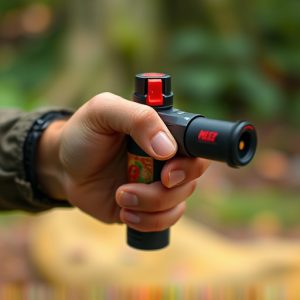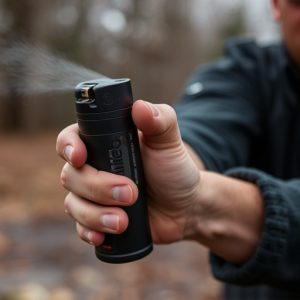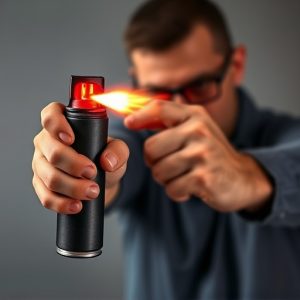Mastering Bear Spray: Top Application Techniques for Ultimate Protection
Tactical inflammatory spray, particularly bear spray, is a powerful non-lethal self-defense tool aga…….
Tactical inflammatory spray, particularly bear spray, is a powerful non-lethal self-defense tool against aggressive animals and hostile individuals. Effective deployment requires proper training in best application techniques, aiming for sensitive areas like the face and eyes from 2-3 meters distance. Regular practice sessions are crucial for maintaining accuracy under pressure. Selecting the ideal spray involves understanding regional wildlife encounters and tailoring concentration and range accordingly. Mastering "Z" or "T" pattern techniques enhances protection during close bear encounters. Real-world case studies show bear spray's success in deterring aggressive bears, with proper application techniques proving vital for safe escape.
“Uncover the power of tactical inflammatory spray defense systems, a game-changer in wildlife interaction management. This comprehensive guide explores the inner workings and significant role of bear spray in protecting individuals and communities. We delve into best practices for selection, emphasizing key considerations for optimal effectiveness. Learn the art of best bear spray application techniques to ensure maximum protection against unexpected encounters. From real-world case studies to expert insights, this article offers an indispensable resource for understanding and implementing successful defensive strategies.”
- Understanding Tactical Inflammatory Spray: A Comprehensive Overview
- The Role of Bear Spray in Wildlife Interaction Management
- Best Practices for Choosing the Right Bear Spray for Your Needs
- Effective Application Techniques to Maximize Protection
- Real-World Scenarios: Case Studies of Successful Bear Spray Defense Systems
Understanding Tactical Inflammatory Spray: A Comprehensive Overview
Tactical inflammatory spray, often referred to as bear spray or pepper spray, is a powerful non-lethal self-defense tool designed for emergency situations. This type of spray utilizes capsaicin, the active ingredient found in chili peppers, to cause temporary but intense irritation and disorientation in targets, enabling users to escape potential threats. Understanding how this spray works and the best application techniques is crucial for effective use, especially when facing aggressive animals or hostile individuals.
The key to successful deployment lies in proper training and knowing the optimal range and application methods. Best practices involve aiming for the face, eyes, and respiratory system—sensitive areas that will prompt immediate reaction and breathing difficulties. In emergency scenarios, users should spray from a safe distance, typically 2-3 meters, allowing enough time to observe target reactions without risking close contact. Regular practice sessions can help individuals master these techniques, ensuring they remain calm and accurate under pressure while leveraging the power of tactical inflammatory spray as a last line of defense.
The Role of Bear Spray in Wildlife Interaction Management
In wildlife interaction management, tactical inflammatory spray systems, like bear spray, play a pivotal role in mitigating risks posed by potentially dangerous animals, especially bears. When faced with an aggressive bear, the correct application technique of bear spray can be life-saving. The best bear spray application techniques involve aiming for the animal’s face and eyes, as this area is highly sensitive to irritants, providing a swift and effective deterrent. A quick burst at close range is more effective than a long-range mist, ensuring the spray reaches the bear’s mucous membranes directly.
Understanding the dynamics of wildlife interactions and knowing how to deploy these systems effectively is crucial. Proper training in best bear spray application techniques empowers individuals to handle encounters confidently, enhancing their safety during outdoor activities in bear country. This includes learning about the different types of bear spray, their active ingredients, and how wind direction can impact usage. With the right knowledge and skill set, individuals can contribute to a safer environment for both themselves and wildlife.
Best Practices for Choosing the Right Bear Spray for Your Needs
When selecting a tactical inflammatory spray, or bear spray, understanding your specific needs is paramount. Consider factors like the typical wildlife encounters in your region and the distances at which you’ll need to deploy the spray effectively. Different bear sprays have varying concentrations and range capabilities; choose one designed for your environment’s unique challenges.
The best practices for applying bear spray involve aiming low, targeting the animal’s face and eyes. Practice with a training can to get comfortable with the spray pattern and ensure you can deliver a precise dose under stress. Regularly test and maintain your spray device, checking expiration dates and ensuring proper functioning. Always keep it readily accessible in an easily retrievable location.
Effective Application Techniques to Maximize Protection
When it comes to best bear spray application techniques, understanding how and where to deploy the spray is key to maximizing protection. One effective method is to hold the can at arm’s length, aimed directly at the bear’s face and eyes. This ensures a direct hit, which is crucial for neutralizing aggressive behavior. A common technique is the “Z” or “T” pattern: move laterally, spraying in sweeping motions, covering a wide area to create a barrier between you and the bear.
It’s important to remember that range and direction are critical factors. Keep your back against a solid structure and maintain a safe distance, as close encounters can increase the risk of injury. Practice makes perfect; familiarizing yourself with the spray’s pattern and range through controlled exercises will enhance your ability to respond effectively in real-situations, ensuring your safety in bear country.
Real-World Scenarios: Case Studies of Successful Bear Spray Defense Systems
In real-world scenarios, tactical inflammatory spray defense systems, particularly bear spray, have proven effective in various outdoor activities and wilderness settings. Case studies highlight successful deployments during encounters with aggressive bears. For instance, in North American national parks, hikers and campers have used bear spray to deter grizzly bears effectively, especially when surprised or cornered. The best bear spray application techniques involve aiming for the bear’s face and eyes, as this can cause temporary blindness and disorientation, providing a crucial escape window.
These systems are not just limited to wilderness areas; they’ve also been adopted by wildlife management teams and park rangers for crowd control during animal encounters. Efficient use of bear spray has reduced injury rates significantly, showcasing its potential as a non-lethal deterrent. Understanding the unique dynamics of each encounter and employing the right application techniques have been key factors in these successful case studies, underscoring the importance of training and practice to ensure optimal results.
Tactical inflammatory spray, particularly bear spray, has proven to be a valuable tool in managing wildlife interactions, offering effective protection against potential threats. By understanding the product’s mechanics, selecting the right spray for specific needs, and mastering application techniques, individuals can significantly enhance their safety in high-risk environments. The case studies presented highlight successful real-world implementations, emphasizing the importance of proper training and adherence to best practices for optimal results when using bear spray as a defense system.


